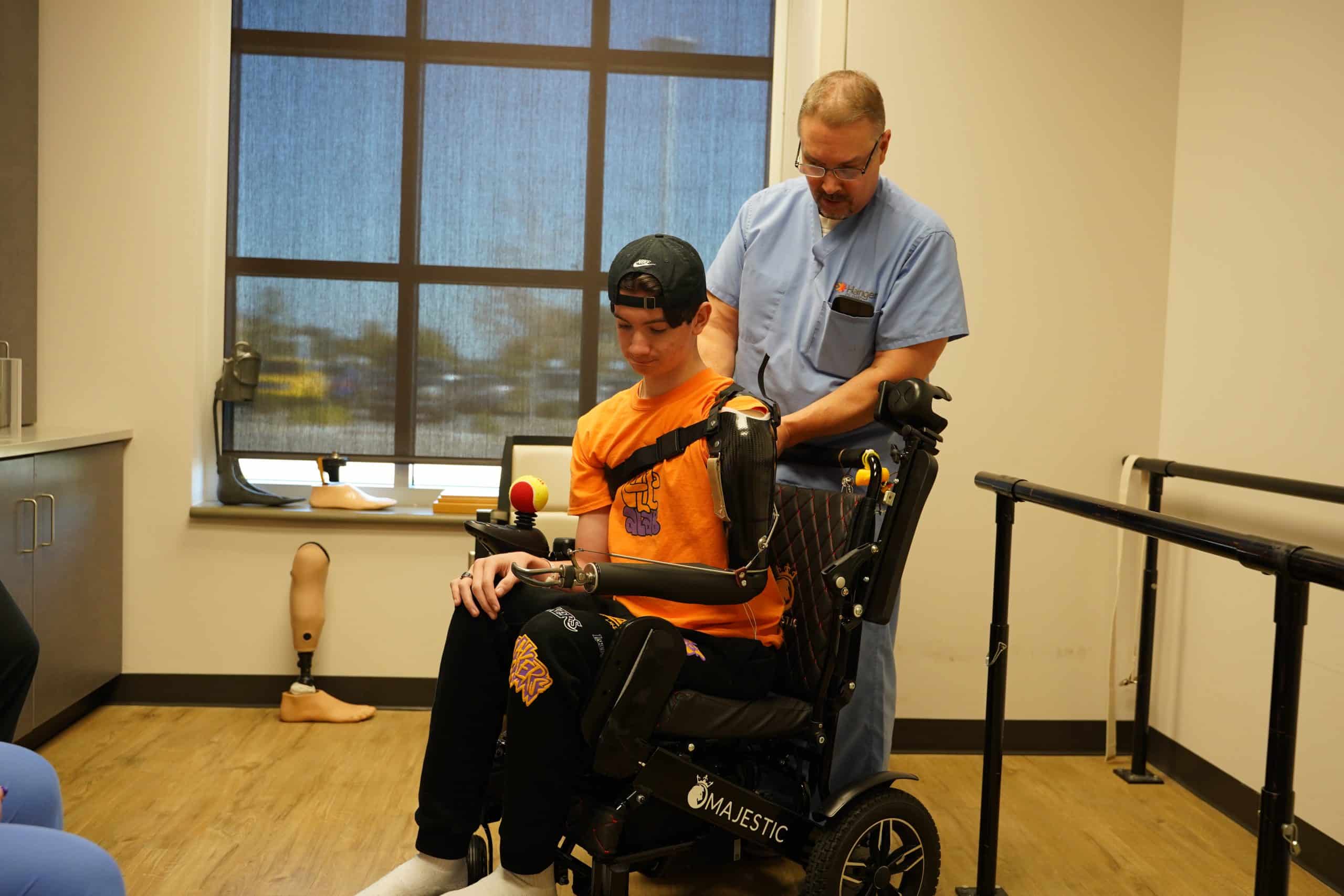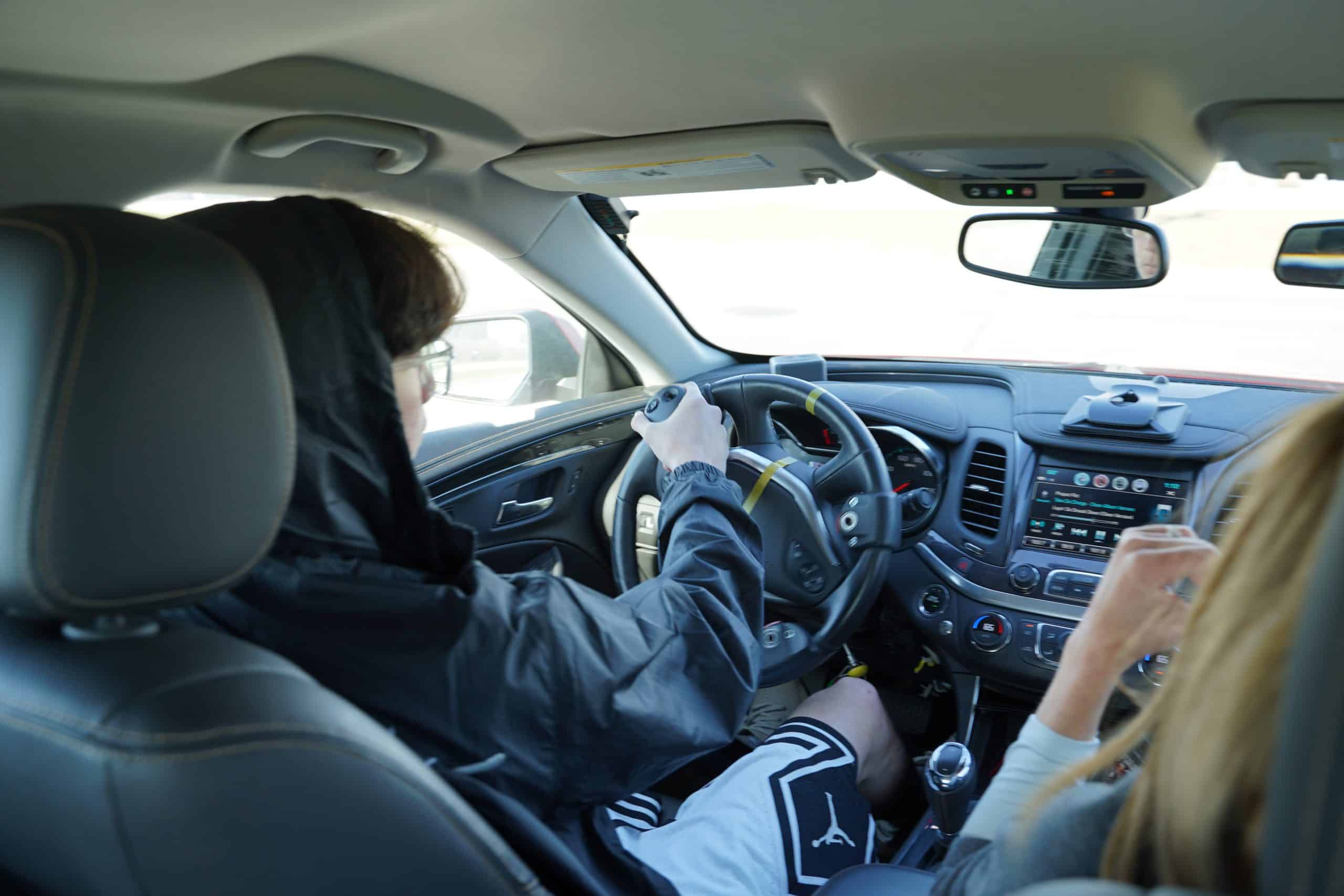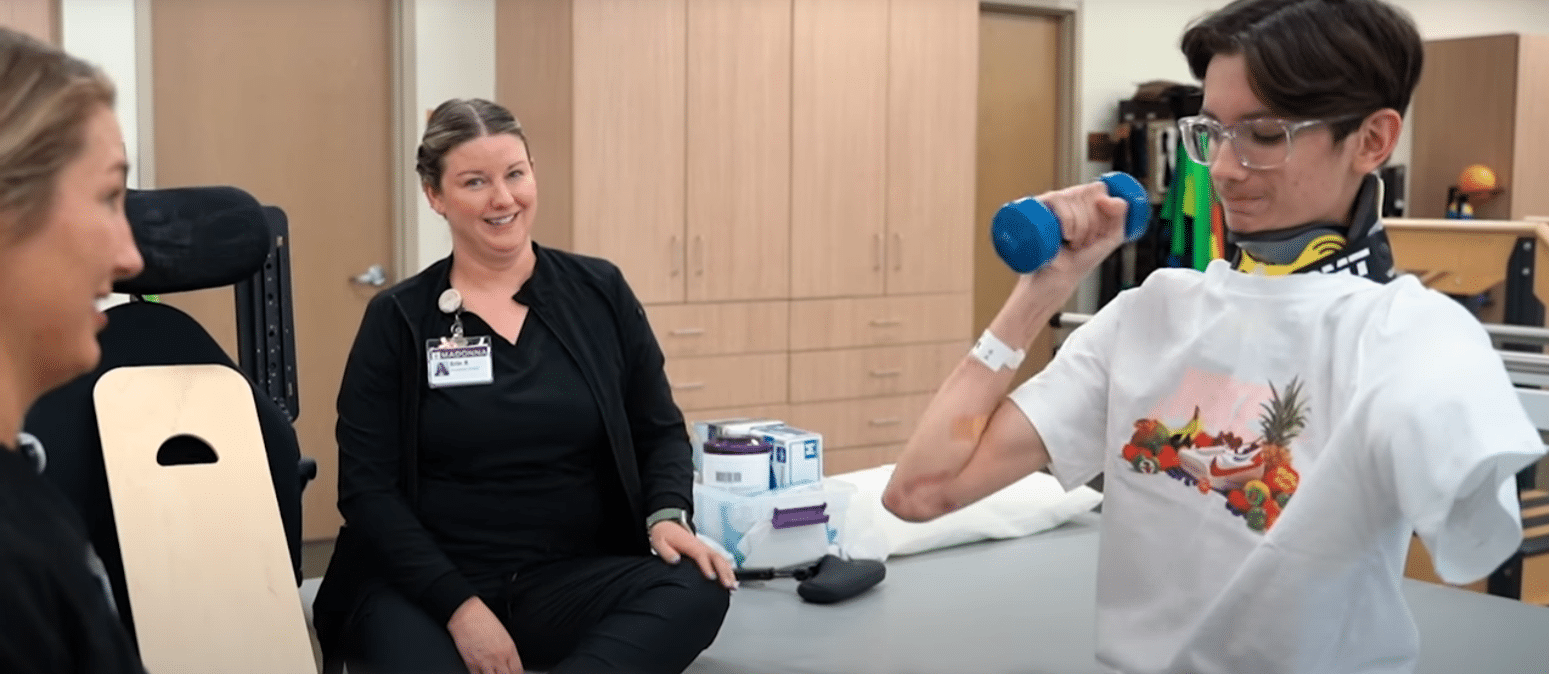Summertime is the busy season for construction workers like 19-year-old Jacob Sulzbach. But a workplace accident in May brought his career to a halt. As a result of the accident, Jacob lost the use of his left leg and had to have his dominant left arm amputated. After spending a month at MercyOne Siouxland Medical Center in his hometown of Sioux City, Iowa, Jacob came to Madonna Rehabilitation Hospitals’ program for injured workers.
Moving through Madonna’s continuum of care, Jacob began his rehabilitation in Madonna’s Specialty Hospital. Weight-bearing restrictions kept his movement limited, but specialized technology like the Functional Electrical Stimulation (FES) bike allowed him to participate in intense therapy while his body continued to heal. His goal was to ‘wake up’ the muscles in his left leg and adjust his balance to compensate for his arm amputation.
In Madonna’s Specialty Hospital, Jacob rediscovered his love of Legos. The talented teen figured out how to manipulate the blocks and assemble large projects one-handed.
“As a kid growing up, maybe from 5 to 12, my main hobby was doing Legos,” Jacob said. “My mom would get me sets, and that’s what I would always ask for Christmas. Legos have definitely been my main thing to pass [the] time while in the hospital, and it’s given me a lot of happiness.”
Once he could tolerate longer periods of therapy, Jacob transitioned to Madonna’s Acute Rehabilitation Hospital. His dozens of Lego sets came with him. What started with a small set to create the Mario character, Bowser turned into sets with thousands of pieces, including a Ferrari.
“We used to joke around that his room was the museum of our unit,” Bianka Alvarado Milla, OTR/L, a Madonna occupational therapist, said. “He would make these crazy, intricate Lego sets, and every time you came into his room, there’d be a new one to look at.”
Jacob’s other favorite hobby—video games—helped pass the time and soon became a part of his therapy. His Madonna care team created adaptive equipment to help Jacob interact with his environment while feeling like he was playing a game.
Madonna’s engineers at the Institute for Rehabilitation Science and Engineering first collaborated with Jacob to test out several possible adaptations for his Xbox system.
“Working with the Institute for the controller, they were really, really helpful with feedback,” Jacob said. Any little issues I had with the controller, like, ‘Hey, I can’t access this,’ or ‘I think this would be better over here,’ they would take that feedback and give me a different model that would work better. They were really eager to help me in all different ways of gaming, whether that be a keyboard and mouse or the Switch or the Xbox, we tried many, many different things.”
An Institute researcher also created a custom 3D-printed attachment for Jacob’s wheelchair to keep his left leg secure and more comfortable. When his wounds from the accident had healed, Jacob was fitted for arm and leg prosthetics through Madonna’s onsite partner, The Hanger Clinic. A knee foot orthosis, or KFO, kept his left foot in the correct position for standing and walking. He was able to manipulate the arm prosthesis to reach, grab and hold onto items, allowing for greater independence.


“The Hanger Clinic was definitely a huge part of Jacob’s success,” Alvarado Milla said. “We met with them several times. Initially, it was to do the basic fitting of the prosthesis, and then they walked us through donning and doffing the prosthesis, and how to use it for basic tasks like being able to open and close the end of the prosthesis to hold something. They also walked us through different exercises we could do to help strengthen his scapula and his shoulder in order to tolerate wearing the prosthesis.”
During his five-month stay, Jacob took advantage of several unique opportunities, such as Madonna’s work re-entry and driver retraining programs. While he may not return to the construction site, he practiced good time management, social skills and memory by helping the telecommunications department deliver mail each day.
“Another big part of the work re-entry program was learning how to navigate doorways from a wheelchair level,” Alvarado Milla said. “If a door automatically shut behind him, what could he do to keep it open? Those were real-life scenarios that he will have to deal with and problem-solve through so it was really nice to do that while he was here.”
A challenge that Jacob was eager to problem solve was driving. He worked with Sarah Hamilton, OTD, OTR/L, CDRS, a Madonna occupational therapist and certified driver retraining specialist, to identify and compensate for his deficits while driving.
“The main obstacle we came up with was steering,” Hamilton said. “He could manage the steering wheel with one hand, but then we started thinking about all the things your left arm does for the driving task. It’s a lot more than we actually realize. A lot of times in our vehicles we have washers and wipers, and turn signals all kind of over on the left side. As we drive, in order to be safe, we need to maintain one hand on the wheel at all times, and so in order for Jacob to be able to turn on all those secondary functions while he’s moving through his environment, we needed an adaptive device. We were able to come up with a spinner knob that allowed six different functions to be placed within buttons. It attached to the steering wheel and kind of looked like a gaming device. That’s what he used when he was driving so he could access his signals and he could change the pace of the wipers and washers, all within the touch of a hand.”
Jacob and Hamilton also identified ways that he could continue to drive his beloved Jeep by making it adapted to his needs.
“We decided we’re going to see if we can fit his tiny compact power chair in his Jeep, and we practiced being able to fold it down and what adaptive equipment we can put in the rear of his Jeep, so we came up with a hoist lift. He’s hopefully going to work with a vendor and make sure we can fit one of those in the back of his vehicle and modify his wheelchair so that it can stay compact and safely latched. He’ll be able to guide it by leaning on his bumper to get it into his car, and he’ll be able to drive by himself. He won’t need anybody out in the community with him.”
Learning how to manipulate his environment with the use of adaptive technology is a work in progress for Jacob, but the biggest lesson for him is to give himself grace.
“Definitely the biggest thing I’ve learned is to be a lot more patient with myself and allow myself a lot more time to do things compared to how I used to,” he said. “Even simple things like getting dressed or taking a shower, it takes maybe double the time that it used to before, but I’ve learned to not get discouraged with myself and just to persevere through it. That’s just the only way to get stuff done.” His care team says keeping a positive attitude and pushing through obstacles are the most important things for someone with a new amputation to do.
“Initially it is going to be hard and it’s going to be different,” Alvarado Milla said. “Remember, we are still at a very acute phase from injury, so there is a lot more to come. There’s a lot more training that comes with being independent with the use of new equipment, but the more practice you’ll get, the more independent you’ll get with a prosthesis and more independent with [a] return to home and community.”






